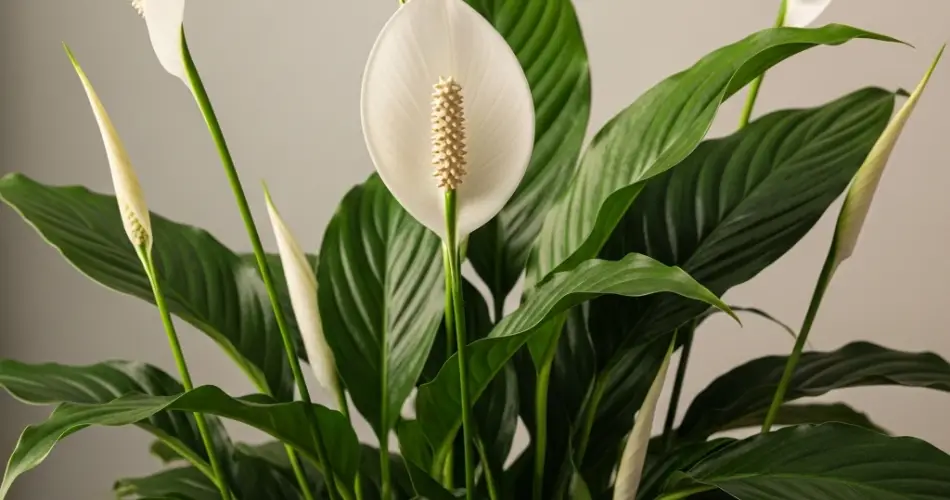The Spathiphyllum, more commonly known as the Peace Lily or “Cuna de Moisés” (Moses’ Cradle), is a popular houseplant admired for its elegant white blooms and lush, dark green leaves. Native to tropical regions of the Americas and Southeast Asia, this plant is not only visually striking but also known for its air-purifying properties — making it both a beautiful and functional addition to any indoor space.
Whether you’re a seasoned plant lover or just starting your indoor garden, the Peace Lily is an excellent choice. This guide will walk you through everything you need to know to keep your Peace Lily healthy, blooming, and thriving all year long.
Why Choose a Peace Lily?
Peace Lilies are loved for their minimal care requirements and graceful appearance. Their name reflects the flower’s symbolism — peace, tranquility, and purity. The white spathes (often mistaken for petals) elegantly wrap around a central spadix, resembling a white flag of surrender.
In addition to their symbolism and beauty, Peace Lilies are also excellent natural air purifiers. Studies have shown they can help remove toxins like formaldehyde, benzene, and carbon monoxide from indoor air, making them a top pick for cleaner and healthier homes.
Ideal Growing Conditions for Peace Lilies
While Peace Lilies are known for being low-maintenance, providing the right conditions will keep them healthy and encourage regular blooming.
1. Light:
Peace Lilies prefer bright, indirect light. Too much direct sunlight can scorch their leaves, while low light can reduce flowering. A spot near a north or east-facing window is ideal. If you notice the plant growing well but not flowering, try moving it to a brighter location — but avoid full sun exposure.
2. Watering:
Watering is one of the most important aspects of Peace Lily care. These plants like consistently moist soil but hate to sit in water. Wait until the top inch of soil is dry, then water thoroughly. In warmer months, this might mean watering once a week. In cooler months, reduce frequency.
A telltale sign that your Peace Lily needs water is drooping leaves — but don’t worry, they’ll usually perk up within hours of watering. Avoid overwatering, which can cause root rot.
3. Humidity and Temperature:
Peace Lilies thrive in warm, humid environments. Ideal temperatures range from 65°F to 80°F (18°C to 27°C). Avoid exposing the plant to temperatures below 55°F (13°C) or cold drafts. For added humidity, mist the leaves regularly or place the pot on a pebble tray filled with water.
4. Soil and Potting:
Use a well-draining, peat-based potting mix. Make sure the pot has proper drainage holes to prevent soggy soil. Repot the plant every 1–2 years to refresh the soil and allow for root growth.
5. Fertilizing:
Feed your Peace Lily with a balanced liquid houseplant fertilizer every 6–8 weeks during the growing season (spring and summer). Over-fertilizing can lead to brown leaf tips, so be conservative with feeding.
Common Problems and How to Fix Them
Even though Peace Lilies are easygoing, they can still show signs of stress. Here are a few common issues:
-
Brown leaf tips: Often caused by over-fertilizing, low humidity, or using water with chlorine or fluoride. Switch to filtered or distilled water and increase humidity.
-
Yellowing leaves: Usually a sign of overwatering. Let the soil dry slightly between waterings.
-
No blooms: The plant may not be getting enough light. Move it to a brighter area with indirect sunlight.
-
Pests: While generally pest-resistant, Peace Lilies can occasionally attract spider mites or mealybugs. Wipe the leaves with a damp cloth and treat infestations with neem oil or insecticidal soap.
Flowering Cycle and Maintenance
Peace Lilies typically bloom in spring and may flower again later in the year under optimal conditions. Each flower lasts several weeks before fading. Once the bloom turns green or brown, prune it at the base to encourage new growth.
Regular maintenance includes:
-
Removing dead or yellowing leaves
-
Wiping dust from the leaves to help the plant breathe
-
Pruning spent flowers to stimulate more blooms
With consistent care, your Peace Lily can remain vibrant and beautiful for many years.
Pet Safety Note
Peace Lilies contain calcium oxalate crystals, which can be mildly toxic if ingested by pets or humans. Keep the plant out of reach of curious cats, dogs, or small children. Ingesting it may cause mouth irritation, drooling, or stomach discomfort. It’s not considered deadly, but caution is advised.
Final Thoughts
The Peace Lily is more than just a decorative plant — it’s a symbol of calm and purity and a natural air freshener for your home. With just a bit of attention and the right conditions, this tropical beauty can reward you with lush greenery and elegant white blooms throughout the year.
If you’re looking for a plant that’s graceful, functional, and forgiving, the Spathiphyllum is the perfect indoor companion.



